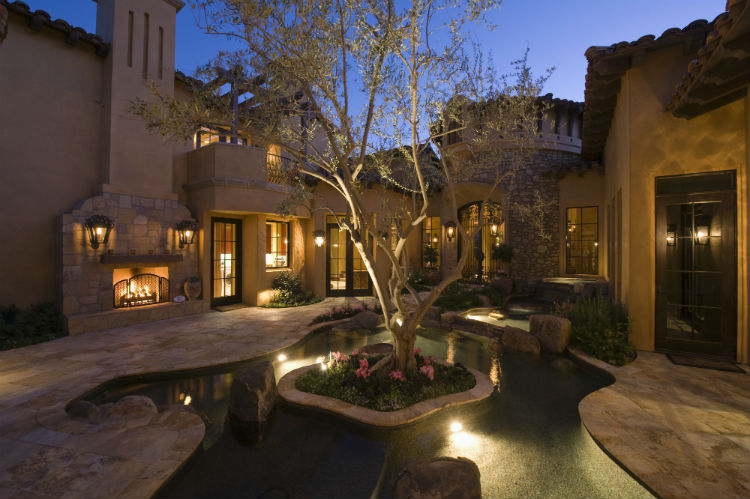
Due to the significant impact outdoor lighting has on a home, several factors should be considered before investing.
Landscape lighting will showcase the exterior of your home, but also make it safer for you and your family to navigate the outdoor spaces. When used creatively, outdoor lighting can create a signature ambiance and showcase the unique characteristics of your home.
This explains why many homeowners consider outdoor lighting a lifestyle investment that pays for itself as a selling feature that enhances the value of their property.
Let’s look at what you need to know to plan outdoor lighting that is right for your landscape.
Plan For The Current and Future Landscape Design
When choosing the type of outdoor lighting for your home, you should always consider what future improvements you could make. If there are no anticipated landscape design changes, you’ll at least want to consider how to accommodate the growth of ornamental trees and shrubs later.
If you plan to eventually make future hardscape improvements, such as adding a new patio, you can take a number of proactive steps to make lighting those additions easier and less expensive.
- Bury 1 1/4″ PVC sleeves to avoid later digging through established root systems
- Install lighting transformers with ample power needed for future improvements
- Plan current and future lighting so that their effects complement each other
Experienced lighting designers know and understand Oklahoma winters provide opportunities for stunning displays. Frosted or snow-covered surfaces will glisten from every lighting source, especially the soft glow from path lights.
One charming winter lighting opportunity occurs when rainfall or wet snow freezes. Frozen droplets that hang from path lights, tree branches, and ornamental grasses twinkle as winter winds blow. Here are a few ways to plan for this.
- Uplight or downlight the outer branches of ornamental trees
- Postpone ornamental grasses pruning until spring
- Choose substantial path lights that will stand above the snowfall
- Consider uplighting the trunks of shade trees
#1. Evaluate Natural and Neighboring Light Influences
One of the most important decisions you must make—and also the hardest—is where exactly to put your outdoor lighting. Start by first looking at your combined outdoor spaces. How big or how small is the area? Are you planning to light the entirety of your space or just parts of it?
Evaluate neighboring light sources. This includes moonlight and the impact of light emitted from street lights and nearby houses. These light sources may be significant in urban or suburban areas and should inform your decisions for landscape lighting effects.
In a neighborhood with many nearby homes, you must vary lighting fixture types and intensities more for aesthetic effects than security. Therefore, your outdoor lighting should focus on dramatic effects such as shadows, focal points, and the home’s architectural features.
#2. Prioritize Activities with Intentional Lighting Effects
Consider the purpose of landscape lighting to achieve desired outcomes.
- Light spaces where you plan to gather and entertain guests
- Illuminate blind spots for safety purposes
- Illuminate walkways and access points to the home
- Highlight unique characteristics of the home or property
By finding the purpose of the lighting, you can determine the location and the type of light fixture you should use. For example, multiple lighting fixture types exist for the respective lighting outcomes. For example, there are abundant path light styles from which to choose. You will discover the light they deliver varies. It turns out the only way to decide for sure is to test them on-site. Most suppliers will have samples available for this purpose.
If you are fortunate to have relatively mature landscaping, evaluate how you can light these plantings and take advantage of their dramatic shadow effects. You will discover that there are many ways to light objects, but usually one or two ways that make them unique. Anyone can spotlight an object, but a creative mind figures out if uplighting, downlighting, or indirect lighting that grazes the object is best for its location and the ambient light.
#3. Establish Year-Round Safety and Security
Your outdoor lighting should illuminate a safe pathway towards your house’s main entrance and all other entry points. This includes your driveway and garage.
Safety considerations are vital for any landscape, especially when features such as pools, ponds, fire pits, and outdoor grills are involved. Lighting should alert people to what’s ahead so that they do not turn a corner and discover the unexpected.
Lighting may create ‘hot spots’ that can become safety hazards when used incorrectly. This occurs when bright lights, like the setting sun, are near eye level, making driving challenging. Sometimes, the best way to solve the problem is to evaluate the effects of the lighting from all angles.
Considering all this before investing in outdoor landscape lighting, you will find that what you choose will be the most effective for your property and the season in which you will use it the most. Don’t waste your time or money investing in lighting that doesn’t make sense for your property.
Proactive Landscaping: Helping Oklahoma Homeowners Enjoy Outdoor Living
Our top priority is creating living spaces that are right for you. We pride ourselves on working with you from concept to construction to make the right landscape for your needs. Contact us today for a free consultation to explore your next landscaping project.

